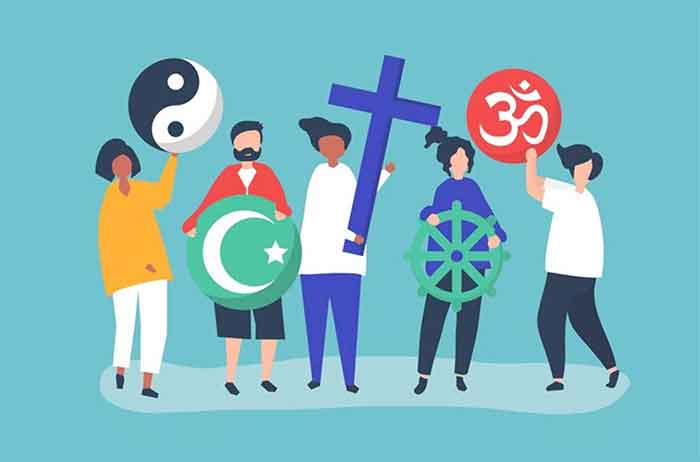
During the last 80 years South Asia has seen several serious disasters such as droughts, famines, floods and cyclones, but a social problem which has caused even greater distress is inter-faith disharmony, sectarianism and the resulting violence. It was hoped at one time that with economic development this problem will diminish significantly, but unfortunately this has not happened and this remains a very serious menace in South Asia causing immense distress and entirely avoidable mistrust and ill feelings in daily life.
This is highly unfortunate and also avoidable. As has been shown in the teachings and experiences of some of the greatest persons of this region, particularly in the course of the bhakti and sufi movements, it is of course possible for people of all religions to live together in peace, but one can go a step further and assert that the essence of spirituality is pursued only by walking on the path of love and harmony and never on the path of hatred and disharmony. In medieval times an extremely rich culture emerged from the intermingling of the people of different languages and religions in India. In the great uprising against colonial rule in 1857 people of various religions including Hindus and Muslims fought in unity with each other. This alarmed the colonial rulers who now embarked on more organized tactics of divide and rule. Despite this, it is important to know and emphasize the remarkable fact that all the topmost leaders of the freedom movement who got the greatest love and support of the people of India, of millions and millions of people, for a very long time—Mahatma Gandhi, Shahid Bhagat Singh, Jawaharlal Nehru, Subhash Chandra Bose, Badshah Khan, Maulana Azad—were all united in their uncompromising commitment to inter-faith harmony. On the other hand there is not a single example of any leader of those times who could get such love and affection of the people on a durable basis on an agenda of sectarianism. It was only a short time before independence that a few sectarian leaders could gain wider support riding on the wave of the partition agenda fanned by the colonial rulers. After the great upsurge of 1942 when the freedom movement developed many new branches of resistance, as the most popular leaders had been imprisoned by the colonial rulers, the colonial rulers also got an opportunity to support the sectarian leaders to acquire a bigger base, paving the way for partition.
Going back to the Bhakti and Sufi movements, the strong tradition of cultural intermingling, the great art and literature produced in the course of these cultural inter-actions, the messages of great freedom fighters, there is a strong base for inter-faith harmony in India as well as in other parts of South Asia. However at the same time the forces which promote disharmony, misunderstanding and at times even hatred are quite active. As a result sometimes it appears that despite all the education and development inter-faith disharmony and misunderstandings are increasing in society. While the situation is worrying in India, in some other parts of South Asia this can be even worse.
Hence there is need for a continuing campaign for inter-faith harmony. This writer has been contributing in a small and humble way to this for several decades in the form of articles, posters, booklets, poems etc. and some of the articles published in the mass circulation Hindi newspapers could reach millions of people, while even some booklets could reach several hundred thousand readers as these were re-published time and again. All this was meant to be used by campaigners at the grassroots level and avoided being too confrontationist, concentrating instead on taking some key messages to people in simple and interesting ways. In earlier days some of these booklets were priced as low as Rs. 2 or 3. We even sold them in stalls we rented at the World Book Fair, together with our other books, and people often expressed surprise that such low price literature can also be produced. The response we got was great, with people often saying why didn’t we get this literature earlier.
One aspect which I emphasized was the historical one, as I felt strongly that history was being repeatedly misinterpreted by those spreading disharmony. At the peak of false temple-mosque disputes, I wrote several articles on how Muslim rulers had been highly supportive towards the creation and maintenance of several temples. I was visiting Rajasthan much during those days and drawing from the history here, at workshops on communal harmony I often asked how the Haldighati battle could be called a Hindu-Muslim battle when the Mughal army was led by a Hindu general and a very important and courageous section of Rana Pratap’s army was led by a Muslim general. We gave many examples of the close cooperation of the kings and people of two religions. Some people responded that this has led to new thinking among them–even though the local facts were often known to them but the perspective made them rethink. Others were more confrontationist and asked bluntly whether for me Akbar was the hero or Rana Pratap was the hero. I replied why don’t you try to see and understand the situation from the perspective of both of them. This interesting exchange led to the development of a new idea which took the shape of a booklet published in Hindi titled Why can’t both Akbar and Rana Pratap be great in their own way.
I also wrote a lot about various symbols of communal harmony and those leaders who had been deeply committed to communal harmony. Aruna Roy encouraged me to bring out a series of booklets on Mahatma Gandhi’s ideas and efforts. The local branch of Khudai Khidmatgars encouraged me to take further my work on Badshah Khan so that thousands of booklets on his life, work and message could reach people.
Inter-faith disharmony and sectarianism is one of the biggest hurdles in the path of development, welfare, peace, happiness, trust, cooperation and unity in South Asia. Our history and culture stand for harmony and not harmony. Those who spread disharmony have already caused immense distress and should be prevented from spreading more distress and discord—this should be the essential message of the campaign for harmony which should be active on a continuing basis.
Bharat Dogra is Honorary Convener, Campaign to Save Earth Now. His recent books include Planet in Peril, Protecting Earth for Children and A Day in 2071.















































